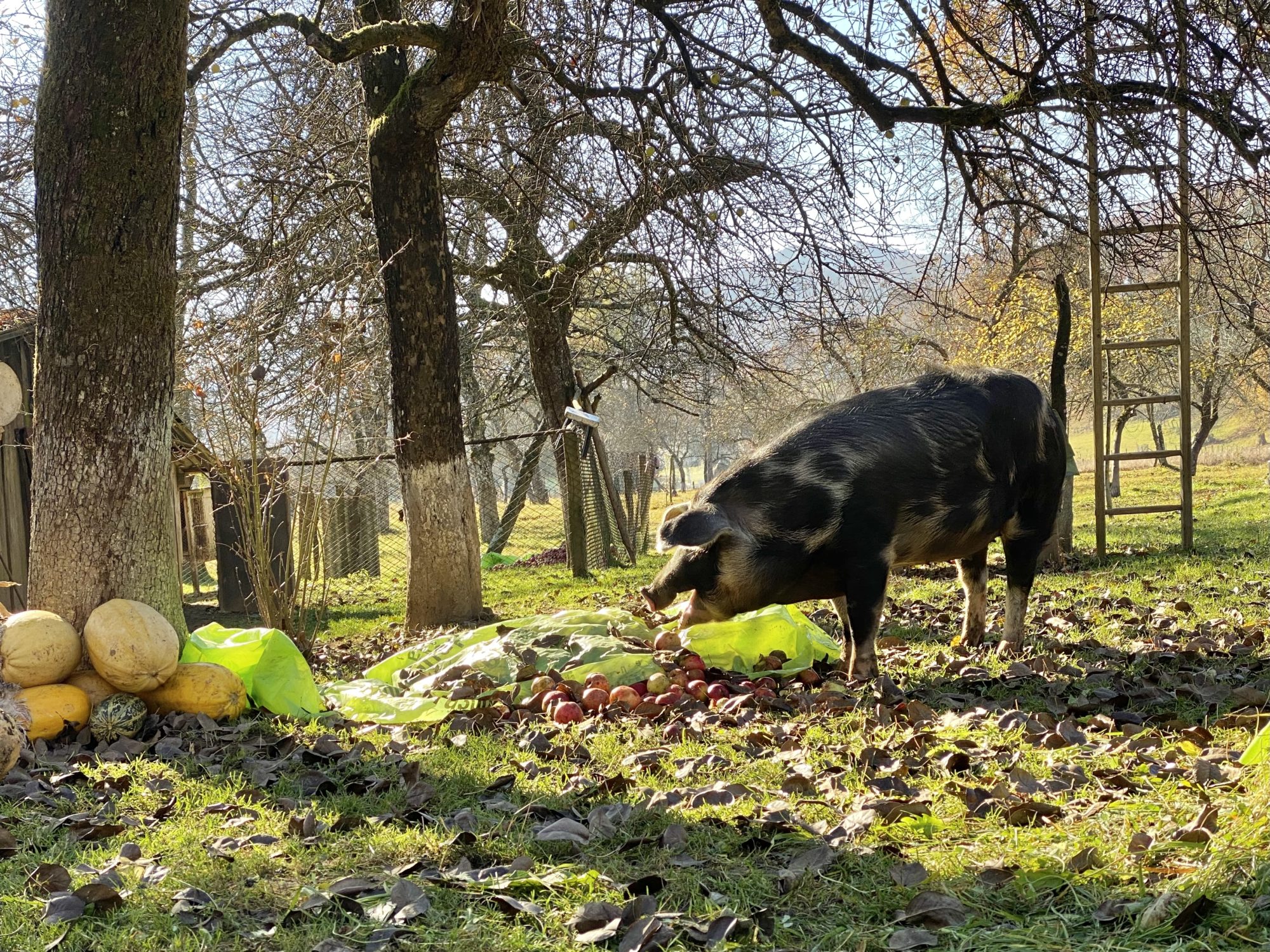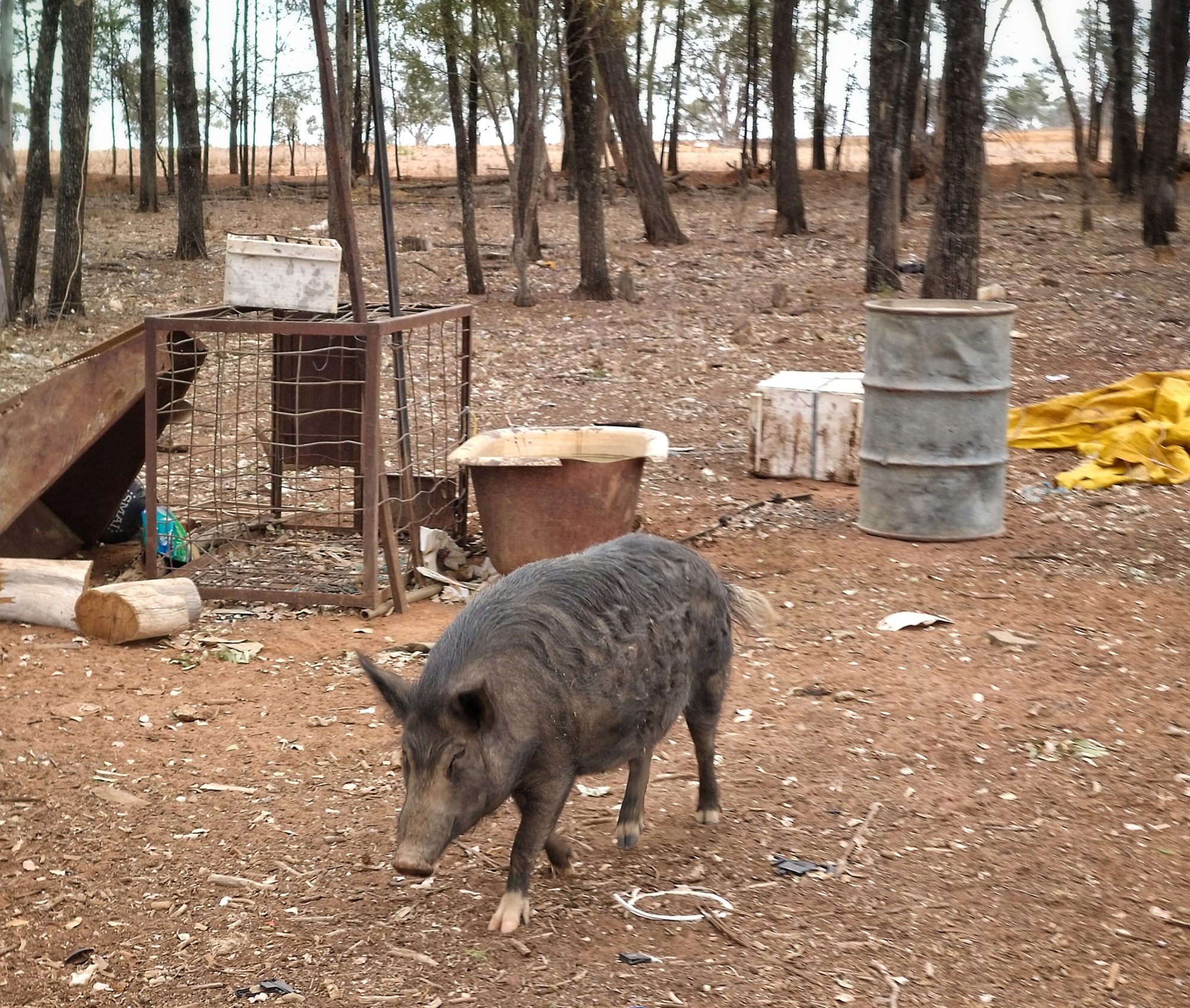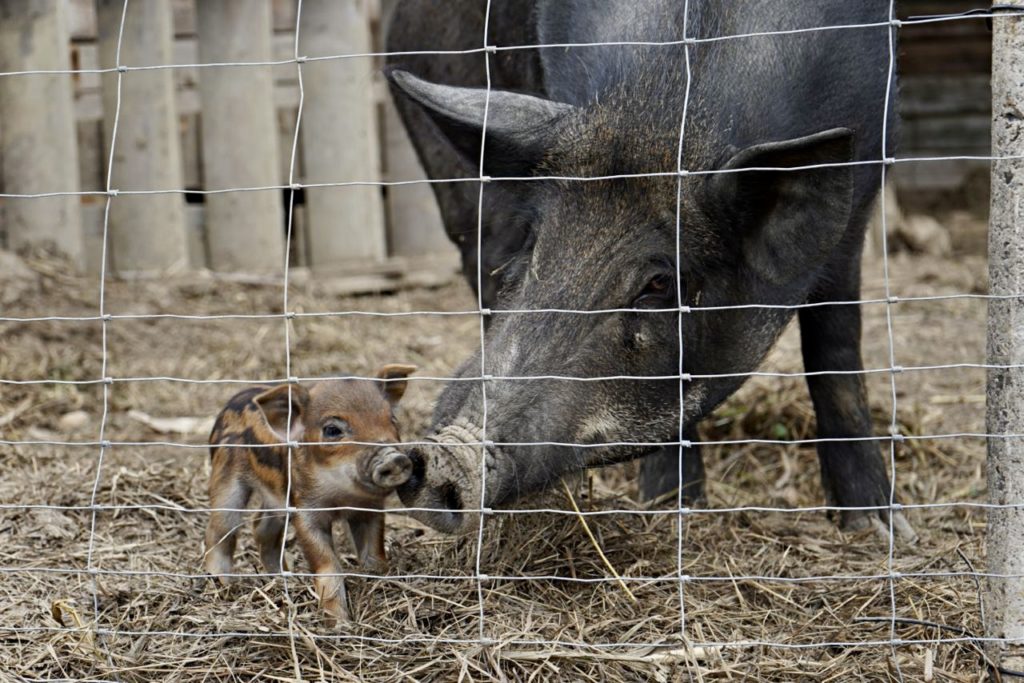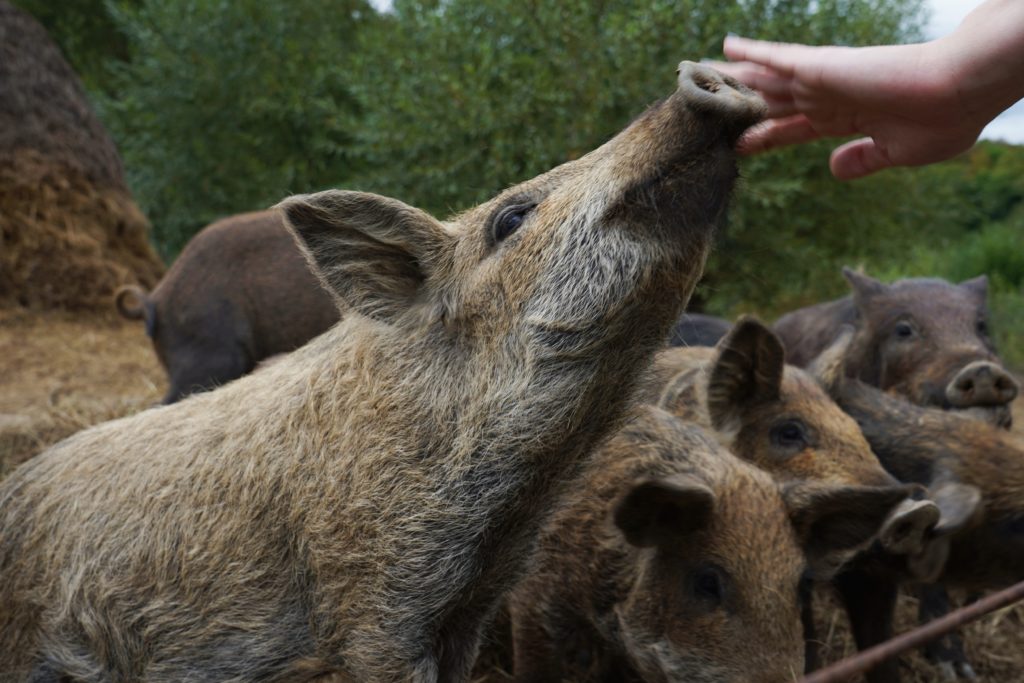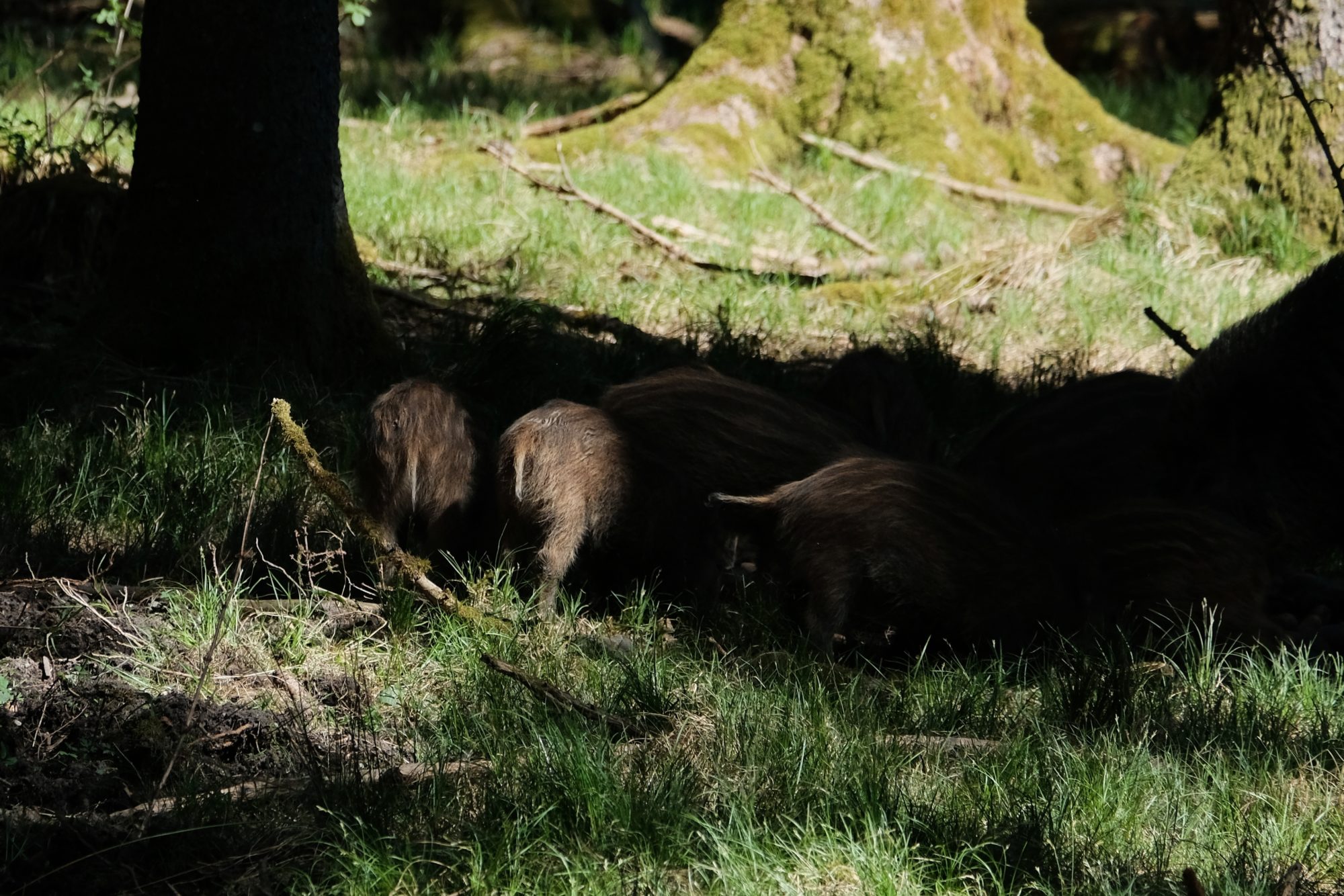FERAL ETHICS – Thinking feral with pigs
Wild beasts, uncivilized children, and biologically domesticated animals living beyond human control. Feral is a term that has commonly been used to describe life which threatens social and ecological orders. Recently, its use has proliferated, applied to those that live on the margins – liminal beings that disrupt narratives about where and how to live.[1] The feral has been let loose to conceptualize the emerging, uncertain, and mangled worlds of the Anthropocene, and for some, the hopeful possibility of environmental futures that move beyond the old orders that brought about our ecological predicament.
Feral captures a range of tensions concerning human relationships with nonhuman beings and their place in the world. There is, it seems, a lot at stake for life understood as feral. For this reason, we need a FERAL ETHICS – a way of dwelling upon and dwelling with life as it unfolds in uncertain and unexpected ways, and a consideration towards ways of engaging with ferality that neither marginalizes, nor glorifies its potential. The following, then, is our tentative sketch of what this ethics might look like, a project that has grown out of our shared research interest in the relational ethics of multispecies studies, but most importantly, our shared love for pigs of all kinds.
A new life
We embrace the vitality that surrounds the use of the word feral.
Describing the drawing together and unraveling human-nonhuman connections, the feral animal’s trajectory suggests a shift in power relations, from human mediation towards nonhuman autonomy. The term’s emancipatory character lends itself to hopeful feminist and queer politics, a liberation from oppressive structures that opens up promissory horizons.
Feral has also been re-interpreted, rehabilitated even, its inherent ambiguity perceived as a means through which to transcend the problematic domestic-wild binary that both defines the term and orders life. Anthropologist Anna Tsing and colleagues use feral as a concept to follow the trajectories of organisms entangled in anthropogenic worlds yet simultaneously escape human control.[2] Feral effects describe, for example, how colonial infrastructure afforded the migration of organisms to alien worlds, or how capitalist environmental disturbances provoke new problematic dynamics among endemic species. The term has also been used to think through rewilding and emergent ecologies, whereby ecological processes are given time and space to unfold with minimal human intervention.[3] Feral, as understood by writers such as George Monbiot, captures both a loosening of control and urge to preserve.[4] These various notions all draw upon the uncertainty and unexpectedness that ferality invokes.
Elsewhere within academic discussion, especially those coming from within posthumanist and multispecies salons, feral has emerged as the new queer, working well as a noun, adjective, and verb which can qualify almost anything! We scholars increasingly appear seduced by its transitive potential, ability to upend power structures, resist established orders and salute alterity. Feral nomenclature fosters feral thinking, feral ways of being and points towards novel feral futures.
Tread carefully
And yet, at the same time, we understand the feral ought to be cautiously embraced, its usage delicately considered. We remain wary of its risks, especially when its celebration is detached from narratives grounded in nonhuman flesh and blood, or chlorophyll and cellulose.
Feral is not merely an abstraction to capture Anthropocene effects, nor hopeful queer and other-than-human futures. Nonhumans labelled as feral in popular, environmental, and governmental discourse are often marginalized and maligned. The term is an empowering political tool legitimizing control and violent intervention.[5] Feral lives are often contradictory, simultaneously threatening others while their own existence is at threat. Our conceptualization of the term suggests we must draw from situated contexts, aware of the different consequences of its use, depending on where and to whom it is applied.
The term itself is in a bind. While promising liberation from binary Western orders – wild/domestic, pure/impure, natural/unnatural – feral cannot make sense without such framings, ones that enable its in-betweenness, liminality and subversiveness. Likewise, while the feral speculates multiple disorderly futures, it is also held against long-standing temporal conceptions of nonhuman belonging and place.
Those defined as feral are often perceived as unbelonging, out-of-place and without a home in the contemporary world (at least, according to common anthropocentric classifications of home). In some cases, feral lives belong to species or populations who can never become truly wild nor belong unless they return to domesticated ways of being. In the case of rewilding, it is those whose home have yet to emerge. The feral describes beings who currently fall outside “available frames of meaning” and value,[6] including the cultural protection, sympathy, and care extended to animals living within domestic and wild domains.
Ethical needs
The feral provokes numerous ethical demands, ones that challenge intrinsic principles and universal codes humans develop towards the more-than-human.
An ethics based on the feral is cognizant of the tensions inherent in the word’s multiple interpretations. Rather than using the word feral to foreclose life as desirable or undesirable, a feral ethics is open to the possibilities of alternative narratives, ones that attend to the maligned, liminal, and marginalized. It means asking awkward questions about how we relate to beings inhabiting spaces that fallout of human control or interest or how we account for bodies, biologies, and ecologies that are unfamiliar, provocative and potentially troubling.
We need an ethical consideration that suits novel, risky, adaptive, proliferating relations and emerging more-than-human worlds. A feral ethics is deeply aligned with the ethics espoused in contemporary multispecies scholarship, ones promoting relationality, generosity and care.
To develop a feral ethics we need a model organism, a feral model. We choose the pig, Sus scrofa (and to be clear, here we include ‘wild boar’), an animalian disruptor of orders and systems.
Why pigs
Sus Scrofa orpigs are a single species that are commonly characterized as wild or domesticated. This includes the wild boar of Europe and Asia, white and rare domestic pig breeds, or the feral pigs of North America and Australia. There are multiple reasons why pigs are good subjects to think through feral and ethics together. We want to especially highlight their ubiquity and multiplicity, shape-shifting and transgressive nature, and their complex agency.
First, pigs are a ubiquitous and cosmopolitan companion species. Pigs evolved and spread out across much of Asia, the Middle East, and Europe before the arrival of Homo sapiens in these areas.[7] In many parts of the world, wild pigs continue to live in ambivalent forms of co-existence with people in urban, agricultural, and forest ecologies. They are increasingly in contact with humans, proliferating in the environmental conditions of the Anthropocene.
Pigs were among the first animals to become biologically domesticated. They remain popular and easily manageable backyard livestock across the globe. The bodies of pigs are omnipresent: through industrial slaughter they serve not only as common food but are also the material basis for a wide range of popular consumerist products.[8] And where wild pigs did not historically live, the transportation of domesticated pigs by Polynesian explorers and European colonialism enabled their spread to new worlds where they ran wild. From this multiplicity of social and ecological contexts we perceive a remarkable diversity of human-porcine relations, ones which frequently undermine simplified categories.
Second, the differences perceived between domesticated and wild pigs – especially regarding their habitat, behavior, and appearance – blur upon closer examination. Pigs have a habit of seamlessly moving between domestic and wild domains that can destabilize the Western, modernist orders commonly applied to arrange life. For millennia pigs co-existed with humans through a flexible proximity, moving in and out of domestic spheres, and likely at times domesticating themselves. We can see this adaptability in contemporary wild pigs whose habits are surprisingly plastic and who often learn to navigate and live alongside people in urban environments.
Domesticated pigs did not necessarily require intense human mediation and for centuries lived free-range, feeding in both human habitation and forests and possibly breeding with wild pigs.[9] And if domesticated pigs begin living in the wild, they will quickly adapt, expressing physical traits similar to their wild kin – such as long black bristles, longer legs, and elongated snouts. The pig’s tendency to transcend the wild-domestic binary reminds us that any ethical consideration needs to be relational.
Third, pigs are beings that demand complex ethical treatments of their agency. On the one hand, pigs and their worlds are often the subjects of intense control and violence. Pigs are apprehended within and unmade in industrial piggeries, their bodies standardized, mechanized and slaughtered in closely mediated environments. Wild pig habitats and populations in parts of Europe are managed for the purpose of hunting. And feral pigs in Australia are often scapegoated for being considered invasive, and so culled en masse.
Yet on the other hand, pigs express significant agency and power to create the worlds they live in, sometimes at the detriment of humans and other forms of life. Introduced pigs in Australia might also be conceived as co-colonizers of the European empire, their entrenchment in new worlds further damaged marginalized native ecosystems and appropriated the food sources of Indigenous peoples. The rapidly proliferating wild pigs of Europe, benefiting from anthropogenic environments and behaving in ways that seem out of place even in their own homelands, are placing increasing pressure on already stressed other-than-porcine wildlife. And even a domesticated pig – given hunger, proclivity and the chance – might eat their human companion.[10]
Situating a pig’s feral relations
Generalizing feral narratives serve an important purpose, but to truly understand feral pig ethics, they need to be contextualized through ethnographic stories. These help reveal the curiosity of pigs, their human relations, the feral questions they help us ask, the norms they challenge, and categorizations they rework. Let us turn, then, to Australia, Great Britain and Ukraine, for some complex tales about pigs.
Australia: Pig-pig
Our first example is the sow in the picture below, called Pig-pig. She is two years old, lives on the property of Scott and his son in the state of New South Wales, Australia, and was met by Paul over the course of three interviews with Scott in late 2019. Both the father and son are pig hunters, and Pig-pig was brought home after they killed her mother. She is a companion pet for the son, valued as a guard-pig and potential future lunch by the father, and adopted as a family member by a group of hens. Pig-pig does not live in a pen, has free range of the property, and takes daily baths in a cast-iron tub. She is tolerated by the pig-hunting dogs.
Despite living as part of a multispecies home, Pig-pig is still seen as feral by Australian authorities: part of a vast, unruly population of free-living pigs considered aberrant to the national order and destructive to the country’s ecologies and economies. To be identified as feral in Australia is not only to live independent of human husbandry, but to also have the “wild” characteristics Pig-pig also possesses, for example, the long snout and dark hair typical of the European wild boar. In Australia, to be branded feral is to be made cullable, reduced to a form of bare life that must be suppressed or eradicated. In fact, the only lawful way of interacting with Pig-pig is to kill her. Being transported and kept alive – as Scott and his son did with Pig-pig – is illegal.
Feral here does not embrace but retreats from uncertainty and reduces the animal to only its negative effects to justify lethal control. Further, calling Pig-pig feral does not have any transgressive or liberative potential. Instead, it functions to draw essentialist distinctions between free-living and domestic-living pigs. Ironically, Pig-pig, despite being domesticated, can no longer become domestic. Perhaps the greatest violence done to pigs by naming them feral is to deny their ability to move between domestic and wild domains, thereby denying their plasticity and promiscuous talent to form novel relations with others and environments. A talent that has been central to Sus scrofa’s evolution and spread across the planet. And a talent possessed by Pig-pig.
By following this individual pig, we can tell a different and subversive story about free-living pigs in Australia, one that apprehends other facets of these animals obscured by the branding and judgment of feral. Given the chance, Pig-pig was able to become with others and develop unexpected affective relations of kinship, tolerance, and companionship in a multispecies family – a possibility enabled in an illegal and transgressive relationship and with the unlikeliest of human partners. And by accounting for Pig-pig’s genealogical trajectory – moving from domestic to wild and to domestic again – her story denies the power of either one of those categories to exclusively define her. She is not out of place in either domain and so the Australian concept of feral can have no meaning here (apart from the very meaningful threat of death if spotted by the authorities or a concerned member of the public). Perhaps in this sense, Pig-pig represents the transgressive aspirations of the new ferality that escapes the old social orders.
Great Britain: The un-named Sow
In contrast to Australia, wild boars were once common inhabitants of the British Isles, a “native” species, in conservation parlance, framing their ecological belonging. Their hazy disappearance in the Middle Ages prolonged until the 1980s, at which point farmers began diversifying their businesses and turned to wild boar as a novel form of livestock. Although initially confined to fenced enclosures, many animals escaped or were deliberately released by “activists” seeking to unbind these farmed wild animals.
Rather than a celebratory return, however, the English government categorized these revenant, de-domesticated beings as “feral wild boar,” demarking their unofficial presence as troubling and undesirable. This is not merely explained in relation to their subversive spatial transgressions, but also their questionable genetic purity: for policymakers, historic accounts of wild boar cross-bred with domestic pig breeds disrupts notions of “nativeness” and belonging. In Scotland, such doubts have resulted in their labeling as “feral pigs,” this political border underlining porcine fluidity by transforming wild boar to pigs and vice versa.
These feral presences commonly live on the margins in isolated and precarious collectives that are only partially visible. Officially, there is little attempt to understand these animals, nor make sense of their presence. Rather, they exist as abstracted populations, increasingly framed as nebulous risks whose potential proliferation and disease ecologies threaten insecure futures. As such, they commonly emerge as objects to be controlled by private landowners or subjected to localized government culls. But, of course, there are alternative ways to narrate such lives.
Just as in Australia, in England another individual pig became briefly familiar, though unlike Pig-pig, she does not have a name. Let us refer to her as “the Sow,” for that is how people who lived close to her often noted her presence when she inhabited the edges of a woodland where Kieran also lived, several years ago. She only ever lived in the open – the descendant of animals who escaped a farm over a decade prior – but would forever be classified as feral: not wild, not “native,” nor officially belonging. Perhaps she was “impure,” but she looked like a wild boar. She was also an elusive presence, the pressure of culling making her wary, nocturnal, and flighty around people. Ferality, in this context, speaks of vulnerability, uncertain futures, and finding ways to survive, adapt, and negotiate danger.
To better comprehend the Sow as a neighbor required a patient form of engagement: tracking, attuning, encountering, observing. Such a strategy revealed her as more than just an object to be managed, but a subjective, creative, and social being. She was a matriarch, the head of a sounder (a porcine family group) that transformed rapidly over time, shrinking and expanding as family members were born, reproduced, left or died. The Sow and her family would touch, chatter, grunt and sniff together. They engineered ecologies, formed habits and created meaningful places, embedding porcine significance in specific trees, plants, soils, rhizomes, invertebrates, wallows, and the like.
Attending to the Sow in such a manner would suggest she did belong, at least when considered through her own feral logics and ways of being, in contrast to abstracted political framings which suggest she could not. Did because she vanished several years ago; her feral transience living on through her descendants and haunting, remembered impressions.
Ukraine: Swine Herds
While the Sow was denied status as a native wild boar in Britain, and Pig-pig will never be recognized as a domestic pig in Australia, in Ukraine smallholders deliberately blur corporeal and spatial boundaries between the wild and domestic. For centuries in western Ukrainian Transcarpathia, livestock pigs were overseen by swine herders and allowed to free-forage in abundant beech forests. An increase in better-paid work opportunities over the last two decades, however, has led people to give up herding these agile and difficult-to-control pigs. Now, most pigs are kept in closed pens and instead of freely feeding on the forest and agricultural lands, they are metabolically integrated into their owners’ households, fed with industrial grains, garden scraps, and kitchen waste.
Laura’s research, however, has revealed how the transgressiveness of pigs has recently come back into play. Some smallholders have reintroduced free-range husbandry and now encourage their pigs to free-forage on the edge of or inside forests. Rather than a swineherd, these porcine ranging areas are defined by electric or wooden fences. These husbandry practices are combined with experiments in breeding. More and more pig owners mix domestic pig breeds with wild boars to produce animals that need less care than the usual Sus scrofa domesticus. These new pigs can live outdoors all year round, are more flexible in their eating habits and (allegedly) more resistant to various diseases. By breeding hybrids, liminal porcine kinds that elsewhere are deprived of their raison d’être and home, the feral is deliberately invited into the domestic sphere. “Our pigs may be semi-wild, but in fact they are domestic animals to us,” claims one of the pioneering breeders.
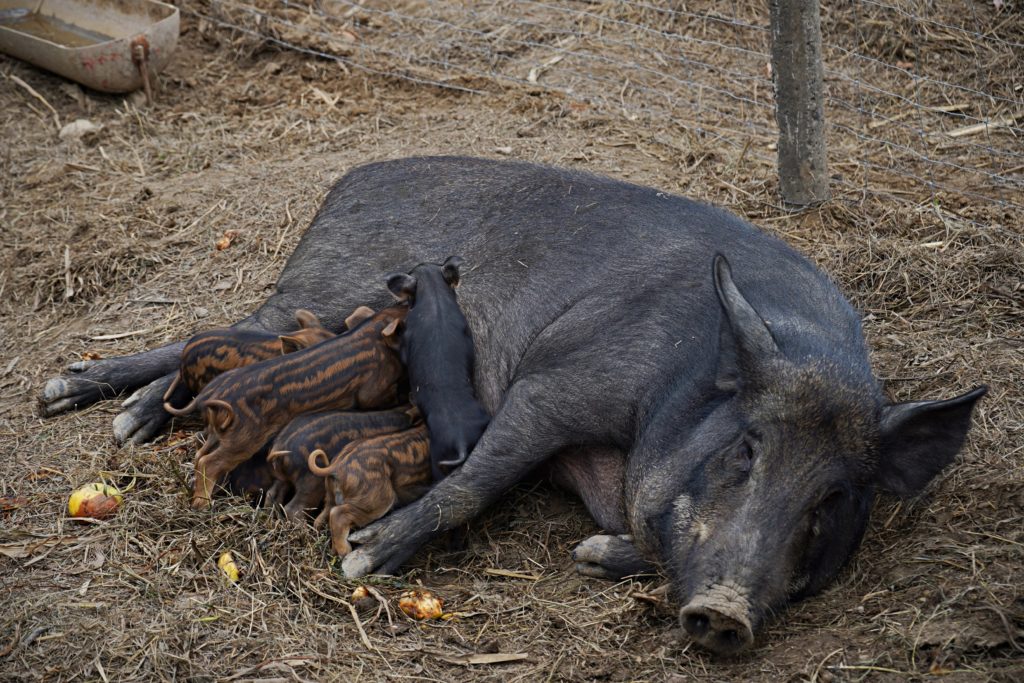
Smallholders’ pigs in Ukraine
© Laura Kuen
Even though Ukrainian Transcarpathians have a term for feral –здичавiлий (zdychavilyǐ) – they do not apply it to these new pigs, since they are still animals subjected to people’s care and are counted as part of their household. However, what if we categorize these emerging pigs as feral? Instead of assuming smallholders are returning to historical modes of husbandry, can the feral help us attune to the unexpected possibilities of this shift, whether between the human and pig, or within the contemporary landscape?
Letting the feral in is not without consequence, also in Transcarpathia. Blurring the line between domestic and wild domains changes what the very category of the domestic contains. People’s openness towards domestic pigs possessing an increased unruliness does not always go uncommented upon in the social fabric of the village. Some residents reject eating hybrids’ meat as they perceive it as ‘not domestic-enough’ for their taste, while others celebrate the presumably more adaptive, robust (and natural) character of these pigs and type of husbandry.
Although viewed with skepticism at times, in Transcarpathia the feral (without being called feral) is welcomed and actively brought about. Feral-ness is valued as a strength, not a flaw, and feral qualities allowed relationships to change with both people and others.
Pigs make us struggle. They break down established classifications used to guide our behaviors towards and interactions with other-than-human beings. These three examples show the problematic nature of taxonomic-legal categorizations of wild, domestic, and feral to capture the complex entanglements between humans and other animals and inadequately describe them. It is for this reason that we suggest a feralized ethics to go beyond those ethical approaches commonly invoked in nature conservation or domesticity.
Feralizing ethics and methods
Feral emerges as a political tool reliant on various cuts and transformations mobilized to control unwanted or subversive life. It evokes important questions about belonging and risk – are feral lives threatening to others and if so, in what ways? How can they be understood and mediated if we step away from the comfort of our anthropocentric position? Feral lives should also make us think about our responsibilities (or response-abilities).[11] They require sensibility and consideration of that which is defined as feral and those whose lives emerge as feral via indirect human influences.
So, what would a feral ethics look like? Ethics is typically codified in a set of rules. But can we imagine an ethics without fixed protocols and control? Would a feral ethics mean going back to the Hobbesian state of anarchic nature? Could a feral ethics offer a chance to confront the fuzziness of life in new, more insightful ways?
Below we propose six strategies for developing a feral ethics that have been directly informed by our own encounters with pigs and their people, as well as our ethical reading of multispecies and more-than-human research. These are not meant to be complete nor universal guidelines, for we consider experimentation and playfulness an integral part of feralizing ethics and ethicizing the feral. Rather, they are an invitation to creatively re-examine and re-think the objectives and implementation of ethics through a lens of the feral.
1. Feral ethics lack universal and rigid protocols
A feral ethics cannot be contained within or dictated through codes or protocols (we embrace the irony that our proclamation begins with a numbered list!). It is concerned with those nonhumans, relations, and worlds which were at one point considered tame and predictable, but now escape our agency to control or comprehend. A feral perspective might see this potentiality to become unruly as inherent in all forms of life. Uncertainty demands that what constitutes good relations must be a decision that emerges in situ, that follows and responds in time as life unfolds. A positioning that requires us not only to attend to contextual peculiarities – to historical, cultural, biological, and biographical complexity – but also to be there, embedded and embodied in place with others, and not abstracted at a distance. Consequently, a feral ethics may not translate between different worlds, while the considerations and actions we take may not be applicable, or even interpretable, elsewhere.
2. Feral ethics has no pre-established sense of goodness or belonging
As we learn through places/geographies where life appears feral, environmental and ecological outcomes are complex. Feral relations can be disruptive, destroying native or marginal nonhuman lives and ecologies. Focusing solely on this negative agency is often at the expense of being open to the wondrous, fertile and valuable aspects of more-than-human feralities. Feral pigs can destroy eggs and habitats of native birds but also shape environments of native species to thrive in different ways.[12] The feral can be both destructive and generative. A feralized ethic asks that we do not privilege either aspect in service of pre-conceived ideological positions. It emphasizes a curiosity in the agential multiplicity other-than-humans might possess – for example, the capacity of feral pigs to both create havoc and vitality. It seeks to go beyond rigid conceptions of belonging, ones grounded in baselines of a stable nature which determines the rightness or wrongness of other-than-human existence. Importantly, rather than foreclose these risky and ambivalent relations, a feral ethics finds ways in which they might exist and sustain, and to think and act more carefully through alternatives to hegemonic narratives.
3. Feral ethics embrace vulnerability
Feral ethics call attention to the experience of vulnerability when living with the feral. There are two senses of vulnerability here. First, the vulnerability required by people when exposed to the uncertain and unexpected, to allow ourselves and our conception of the world to be shaped by more-than-human agencies that exceed complete comprehension and our capacity to control. Second, it is the vulnerability of life that seeks survival outside of the orders of modernity. Our ethical engagements with these more-than-humans must be sensitive to the precarity of their existence, including the risks and consequences of our desire to draw attention to them, to empathize and give voice to the marginal, abject, and feral ways of being. In Great Britain, even in localities where wild boar traces are everywhere, for many people it is taboo to reveal publicly where they are encountered. Naturalists who photograph wild boars withhold their localities from those who might threaten them. Online publics seeking their own feral encounters are politely told to follow their own noses. Concealing specific wild boar presence is understood as a means to protect their precarious existences from the rifles of government rangers who cull or the shotguns of poachers. Sometimes, therefore, feral ethics is about choices that restrict connections, to maintain distance from feral spaces, and respect the animals’ need for discretion.
4. Feral ethics grapple with the trouble of our entanglement
A critical animal studies approach to animal ethics perceives an inherent good in wild relations with nonhumans, since wildlife remains relatively free from human intervention, compared to domestic relations. An ethics that is feralized avoids this ideological disposition towards purity. Just like the pigs in Ukrainian Transcarpathia who craft a flexible proximity between households and the forest, a feral ethics allows for the maintenance of distance, yet is also alert to how deeply entangled we are with nonhuman worlds. An ethics of care also rejects paternalistic principles of stewardship, yet aims to not idealize nature.[13] Feral ethics thrives in such tension and begs uncomfortable questions. How can we become vulnerable to the feral, to its unexpected turns, yet also come to terms with our implication and role in the new worlds taking shape? Which animals are unfairly advantaged? When should we intervene and how do we make this decision, whether it be acts of care or killing?
5. Feral ethics nurtures future relations
Whereas wild ethics have historically been concerned with preservation and maintaining the relations of an imagined past, a feral ethics is open to becomings emerging as future relations. Again, this is not in the sense of a progressivist molding of new creatures according to our tastes and desires. At the same time, ferality allows for looping temporalities, like the ‘return’ of wild boars to England and coming back to partly forgotten and seemingly antiquated practices, like the free-foraging and hybridization in Ukrainian Transcarpathia. Feral ethics cares about the worlds that we cannot make sense of yet. Given that we can only follow contexts as they unfold and pay close attention to their shifting dynamics, a feral ethics requires humility: we cannot know what will come to pass. It demands simple observation, seeking to understand, and a suppleness in our response-ability to the world.[14] This is not to say that it assumes a passive position, as we inevitably co-create these worlds yet to come (see point 3).
6. Feral ethics are grounded in feral methods
Feral ethics requires particular methodological approaches, ones that not only explore the uncertainties and alterity of the feral, but which themselves also unfold with precarity and vulnerability. Feral methods, perhaps feral ethnographies, might be discomforting for researchers as they follow stories which are difficult to grasp, comprehend and unpack. Sometimes this might require uneasy alliances with actors to whom affinities are not initially desired. Indeed, as feralities are never straightforward and singular, their exploration might draw researchers to people, critters, plants, microbes or places which are anathema to their pre-existing sensibilities: those that kill or threaten, control and proliferate, endanger or exterminate.
A feral ethics also requires methodologies which arrive in unknown places. Failure is ever possible. Exploring ferality can be challenging – feral lives can lack the obvious centers of call that the wild or domestic might have. The spokespeople for feral lives can be less apparent, gatekeepers elusive.
Our own feral methods co-evolved with the pigs. They might appear messy to those who value order and trust classifications. These “boary” methods are generalist in the sense that they allow us to test and taste many kinds of sources of nourishment and information. In seeking out feral relations we started thinking with our “snouts.” Guided by gut instinct we remain creative in our culinary/intellectual preferences and curiously follow promising scents and ambivalent affects. We make our way through layers of material, digging up the dirt, rootling. Although humanities scholars are typically solitary, we learn to work collectively: sometimes herded by institutional forces, other times, freely choosing our own sounders. Stemming from such experimental and experiential methods, a feral ethics looks beyond the scale of orders and is responsive to a world that is already beyond human control. We hope to keep adapting with it towards the worlds yet to come.
Acknowledgements
The Feral Ethics essay is the outcome of two interrelated porcine projects.
The ERC BOAR project (www.wildboar.cz) has received funding from the European Research
Council (ERC) under the European Union’s Horizon 2020 research and innovation
programme (grant agreement No 866350). The FERALHUNT project (www.newwildcultures.com) is co-funded
by the EU (Call No. 02_20_079 International Mobility of Researchers – MSCA-IF
IV, OP VVV, Ministry of Education, Youth and Sport).
[1] Stephanie Rutherford, “The Anthropocene’s Animal? Coywolves as Feral Cotravelers,” Environment and Planning E: Nature and Space 1, no. 1–2 (March 1, 2018): 206–23.
[2] Anna Lowenhaupt Tsing, Jennifer Deger, Alder Keleman Saxena, and Feifei Zhou, eds., Feral Atlas: The More-Than-Human Anthropocene (Redwood City: Stanford University Press, 2020).
[3] Eben Kirksey, Emergent Ecologies (Durham: Duke University Press Books, 2015).
[4] George Monbiot, Feral: Searching for Enchantment on the Frontiers of Rewilding (London: Penguin Books, 2013).
[5] N. T. Rowan and Tracy L. Timmins, “The Politics of Naming Feral: Anthropocentric Control and Feral Pigs in North America,” Feral Feminisms, no. 6 (2016): 46–67.
[6] Danielle Celermajer and Arian Wallach, “The Fate of the Illegible Animal: The Case of the Australian Wild Donkey,” Animal Studies Journal 8, no. 2 (January 1, 2019): 229–58.
[7] Nathaniel H. Wehr, Steven C. Hess, and Creighton M. Litton, “Biology and Impacts of Pacific Islands Invasive Species. 14. Sus Scrofa, the Feral Pig (Artiodactyla: Suidae),” Pacific Science 72, no. 2 (April 2018): 177–98.
[8] Christien Meindertsma, PIG 05049. (Rotterdam: Flocks, 2008).
[9] Mark Essig, Lesser Beasts: A Snout-to-Tail History of the Humble Pig (New York: Basic Books, 2015).
[10] “Oregon farmer eaten by his pigs,” BBC News, October 2, 2012. Accessed (23/11/22) https://www.bbc.com/news/world-us-canada-19796224. “Missing Polish farmer eaten by his own pigs.” KafkaDesk, January 15, 2020, Accessed (23/11/22) https://kafkadesk.org/2020/01/15/missing-polish-farmer-eaten-by-his-own-pigs/
[11] Donna J. Haraway, Staying with the Trouble: Making Kin in the Chthulucene. (Durham: Duke University Press, 2016), 34 and 78.
[12] Daniel J. D. Natusch et al., “Interspecific Interactions between Feral Pigs and Native Birds Reveal Both Positive and Negative Effects,” Austral Ecology 42, no. 4 (2017): 479–85.
[13] María Puig De La Bellacasa, Matters of Care: Speculative Ethics in More than Human Worlds (Minneapolis: University of Minnesota Press, 2017), 143.
[14] Rafael Ramírez and Jerome Ravetz, “Feral Futures: Zen and Aesthetics,” Futures, Special Issue: Community Engagement for Sustainable Urban Futures, 43, no. 4 (May 1, 2011): 478–87; Donna Haraway, “Awash in Urine: DES and Premarin® in Multispecies Response-Ability,” Women’s Studies Quarterly 40, no. 1/2 (2012): 301–16.
